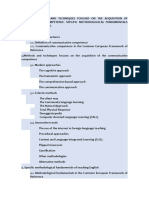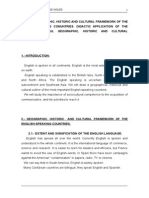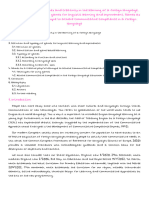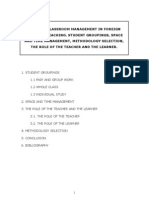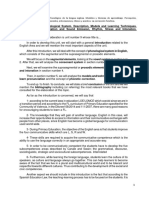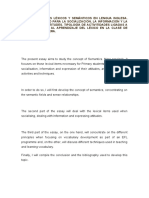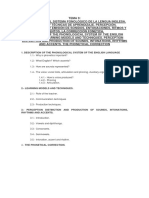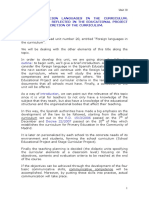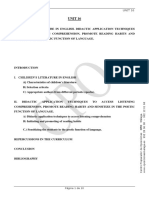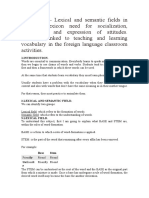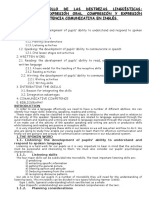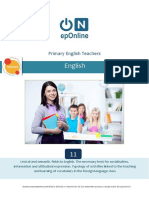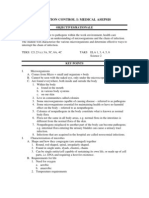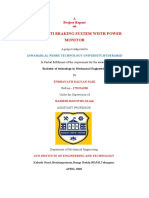Tema 18
Tema 18
Uploaded by
elevatoreCopyright:
Available Formats
Tema 18
Tema 18
Uploaded by
elevatoreOriginal Description:
Copyright
Available Formats
Share this document
Did you find this document useful?
Is this content inappropriate?
Copyright:
Available Formats
Tema 18
Tema 18
Uploaded by
elevatoreCopyright:
Available Formats
OPOSICIONES MAGISTERIO. ESPECIALIDAD INGLS. TEMA 18.
FUNCTIONS OF GAMES AND CREATIVITY IN FOREIGN LANGUAGE
LEARNING. DEFINITION AND TYPOLOGY OF GAMES FOR LINGUISTIC
LEARNING
AND
INPROVEMENT.
GAMES
AS
CREATIVE
PLAY
TECHNIQUE TO ACESS COMMUNICATIVE COMPETENCE IN THE FOREIGN
LANGUAGE.
INDEX.
0.- INTRODUCTION.
1. CURRICULAR CONCRETION.
2.-FUNCTIONS OF GAMES AND CREATIVITY IN FOREIGN LANGUAGE
LEARNING.
3.-
DEFINITION
AND
TYPOLOGY
OF
GAMES
FOR
LINGUISTIC
LEARNINGAND IMPROVEMENT.
4.-
GAMES
AS
CREATIVE
PLAY
TECHNIQUE
TO
ACCESS
COMMUNICATIVE COMPETENCE IN THE FOREIGN LANGUAGE.
5.- CONCLUSION.
6.- BIBLIOGRAPHY.
OPOSICIONES MAGISTERIO. ESPECIALIDAD INGLS. TEMA 18.
0.- INTRODUCTION.
Games are a suitable way to achieve the foreign language learning as they
coincide with the suggestions made from the Order of March the 17th 2015,
which develops the curricula in Primary Education in Andalusia, advocating for
children an amazing way of learning connected with their interests and tastes.
Nevertheless games develop abilities like creativity, being able to offer a great
variety of them to build up the Communicative Competence as well.
1.- CURRICULAR CONCRETION.
The different levels of curricular concretion go from the first one, comprising the
different standards of legislation at nationwide and autonomous region level,
to the school center plan, which is the second one, and the third one which is
the syllabus.
Games convey on an active way teaching, letting students be the real
protagonist, increasing their self-esteem and creativity and maintaining their
interest and willingness to learn and acquire the language skills. All these
aspects are regarded within the next foreign language objectives:
Listen and understand oral messages and use the information obtained to
achieve tasks related to students experiences.
Interact autonomously in easy habitual situations using verbal and nonverbal resources as concerning the social rules on respectfulness and
cooperation.
Read comprehensively texts related with students interests and
experiences to extract general and specific information with a purpose.
Write texts on varied purposes previously worked in class with the help of
models.
Show a progressive and confident receptive attitude towards the own
capacity of learning and using the foreign language.
OPOSICIONES MAGISTERIO. ESPECIALIDAD INGLS. TEMA 18.
2.-FUNCTIONS OF GAMES AND CREATIVITY IN FOREIGN LANGUAGE
LEARNING.
Pupils have an enormous capacity for finding and making games of any kind.
Therefore, if they have fun through games they will find English learning more
interesting and they will develop this skill, creativity, helping them think on their
own by saying things in English.
As concerning Charo Ortega the features of games are the following:
Its a natural way of exchanging knowledge, ideas and experiences.
Make pupils feel sure and free to express their ideas and they can change
them if the context provide opportunities to make them better.
The material that is used supports and guides the game but it doesnt
determine it.
Therefore, from a didactic point of view games hold the following functions:
They achieve an inductive global learning, bringing students closer to
reality.
Make possible the realization of meaningful and functional learning,
enhancing the acquisition of key competences.
Provide variety of situations.
Change the rhythm of the class and maintain pupils motivation.
The distance between teacher and pupils is reduced.
In general, the creative capacity is considered as a constructive and productive
behavior manifested in the action or in the realization.
For Marzollo and Lloyd: Creativity is, basically, an attitude that arises easily in
the young children, but that should be encouraged and strengthen so that our too
logical world does not destroy it.
OPOSICIONES MAGISTERIO. ESPECIALIDAD INGLS. TEMA 18.
Creativity can be based on interpersonal exchanges, guessing, imagining and all
other creative ideas. When this happens pupils will be surprised by their own
capacity to communicate. Therefore, learning made enjoyable and fun.
An activity is creative, according to Torrance, if it is different, new or unconscious,
and creative people have the following features:
They are able to use their free time without external stimuli.
They ask questions that exceed the classic why or how.
They suggest different ways of making activities.
They enjoy drawing or painting.
They are observant and enjoy making new experiments with the objects
that surround them.
From a cognitive point of view creative people are opened to changes, they
contrast experience and theory and they have a high self-esteem.
From an attitudinal point of view they are non-conformist, dont have prejudices
towards people, theyre curious, face new problems and manage difficult
situations.
Methodological strategies that foster creativity must take into account how to
group pupils investigating the accurate activity for the group and planning the
space and time management for the activity. And also must favor opened
processes, encourage childrens initiative in knowledge, building and foster
concept construction from the observation and manipulation of the environment.
Through a scientific method teachers must use the hypothesis to verify its
efficiency. At regarding Ausubels learning by discovering, it provides specific
work for specific problems and it also works on pupils interests. The interrogative
method is based on creative questions that make pupils think and arouse new
knowledge.
OPOSICIONES MAGISTERIO. ESPECIALIDAD INGLS. TEMA 18.
In short, we will have to find a multi-methodological working style that help
students to develop autonomous and respectful learning by enhancing selfesteem.
3.- DEFINITION AND TYPOLOGY OF GAMES FOR LINGUISTIC LEARNING
AND IMPROVEMENT.
Law 17/2007, December the tenth, about education in Andalusia sets that the
teaching methodology will mainly be active and participative enhancing individual
and cooperative work amongst students, and the use of games is closely related
to these guidelines.
Definition: A game is an activity with rules, a goal and an element of fun.
Educators and psychologists agree that a game is a mental and physical activity
that favors the personal development in an integral and harmonious way. Games
are also a teaching resource to search and assess pupils behavior, the learning
process and the own pedagogic intervention.
Games personally involve pupils from an affective, cognitive, and especially,
interactive or psychosocial point of view.
Typology. We can classify games taking in account several factors.
As Piaget proposed, games can be classified according to pupils age because
they increase the repertoire as they grow up. Bearing this in mind we can classify
games taking in account their features and the relationship between students
during the game.
Motor-sensorial or exercise games as concerning objects, body and people.
Symbolic games that consist of imitation and representation. Role games with
role representation and socialized or rule games.
A more specific classification for foreign language area can be those games
related to:
LANGUAGE USE.
Non-verbal games.
OPOSICIONES MAGISTERIO. ESPECIALIDAD INGLS. TEMA 18.
Theyre useful to know one another, to break the ice and to promote
a feeling of union. Using T.P.R. technique pupils listen and perform the
actions. In listen and point, pupils listen and identify the different pictures
of a story. Jigsaw listening is an activity in which pupils listen and order the
picture of a story,
Pre-communicative or facilitating games.
The main aim is not the communication but working on different
aspects of the language, for example, the introduction to basic vocabulary
I went to the zoo and saw
Guessing games, such as, whats in a bag, are based on descriptions
related to the hidden object or similar.
Communication games.
They emphasize communication and develop fluency by using the
necessary strategies and skills. Information gap games, searching
games and exchanging or collecting games.
ATTITUDE THEY FOSTER.
Cooperative games. Students work together to achieve a common
aim. They develop very positive attitudes for their future as
democratic citizens such as tolerance, respect, diversity or
acceptance.
Competitive games. In this case, students play in order to be the
first to achieve the goal. It is very usual and motivating for students.
Bearing in mind the attitudinal contents pupils must be taught the
right position to face when losing in a game and take a liking to
continue participating. Its better to use the latter type of games
because the need for speed often distorts the language use.
Although we can change the method of scoring and give pupils
points for success than to take them away for failure, being more
effective, since nobody feels defeated.
OPOSICIONES MAGISTERIO. ESPECIALIDAD INGLS. TEMA 18.
There are some amusing ways to note down the scores and to
motivate students at the same time like:
~ Draw a big football stadium with as many balls as students
or group of students. Every time they win a point, the ball
advances towards the goal.
~ We can give them a letter for every point they win with the
aim of making up the expression: The Winners!
ACCORDING TO THE TECHNIQUE USED.
Guessing games, fill in the gaps game, exchanging games,
simulation games or problem solving games.
RELATED TO THE MEDIUM USED.
Body games require movement, mime or performance.
Board games are very useful for students to work in pairs and in
small groups. We can make these games more motivating if we get
students involved in making them up. Examples could be
Battleships or noughts and crosses.
LINGUISTIC GAMES
Vocabulary games might be focused on spelling like word chain, I
spy, look for words from a long word, word-search or hang-man. To
work on pronunciation we can use bingo or Chinese whisper.
Structure games might be crossword, role play or discover the
famous person (by asking yes or no questions).
Grouping: Games in pairs or groups of four or five participants are the most
useful ones. An important thing is how to select group members:
We can group students in accordance with their level, being one step
beyond their levels as Stephen Krashen advocates.
We can group them in more relaxed activities like it may be to make a
poster where they contribute with their best skills. Therefore weak and
OPOSICIONES MAGISTERIO. ESPECIALIDAD INGLS. TEMA 18.
strong pupils might be mixed as concerning the multiple intelligences
theory of Howard Gardner.
Forming flexible groups to change when being considered or necessary,
although its a good idea to have fixed groups for the whole year.
We can have group leaders acting as group organizers or mini teachers
where pupils would conduct a drill or dialogue.
4.
GAMES
AS
CREATIVE
PLAY
TECHNIQUE
TO
ACCESS
COMMUNICATIVE COMPETENCE IN THE FOREIGN LANGUAGE.
Games must develop communicative competence emphasizing functionality,
attention and concentration, globalization, variety, motivation, amusement and
close relation between teachers and pupils. Accounting knowledge included in
linguistic sub-competences:
Messages must be produced in a meaningful way (linguistic competence:
when someone is able to use the rules of the grammar in the spoken
language)
Adapted to a concrete context or communicative situation considering the
uses of the linguistic community (socio-linguistic competence)
Interpreting and producing different types of discourses and organizing
them taking into account the communicative situation (discourse
competence).
The use of communicative strategies will also help to the achievement of
communication as being suitable to a determined social and cultural
environment (discourse competence).
Therefore games are useful for the following reasons:
1. Offer a real goal in foreign language learning, since it provides students
with an immediate usefulness.
2. Put into practice vocabulary, structures and pronunciation not appearing
as the aim of the game.
OPOSICIONES MAGISTERIO. ESPECIALIDAD INGLS. TEMA 18.
3. Increase communication between students, providing the chances to
practice fluency and reducing teacher talking time.
4. Improve communicative skills (listening comprehension, speaking, reading
and writing).
5. Exercise pupils ability to react and act by means of language.
6. Allow pupils to check the efficiency of the new language.
7. Develop cooperative and competitive abilities.
8. Show those areas of real use in which students have certain weaknesses,
and the need for additional practice of any specific aspect.
9. Relax anxiety
Games must not be pushed into the background as activities done at the
end of a lesson in order to cover a blank or a time out.
Steps to follow before choosing a game:
Explore what are childrens favorite games.
Analyze which can be better applied to foreign language area.
Make a card of each game for the little toy library. Every card will include:
The goal of the game.
The number of participants and the way they should be grouped.
How to play the game.
Probable conflicts and their solutions.
And possible variations
Role of teachers: they must plan it beforehand to facilitate the necessary
conditions and resources, stimulate, motivate and take part in games
when necessary, for example in order to facilitate the negotiation of the
guide line regulating the activity, or to offer help and the necessary support
to promote change and cognition, that is, making a new and more
complex knowledge.
5. - CONCLUSION.
OPOSICIONES MAGISTERIO. ESPECIALIDAD INGLS. TEMA 18.
All the games we have studied contribute to a full development of pupils and to
the acquisition of the communicative competence. So, we must never forget that
English learning and fun go together, especially with younger pupils.
And as Andrew Wright affirms: Games help and encourage many learners to
sustain their interest and work.
6. - BIBLIOGRAPHY.
Organic Law 8/2013, December the ninth, for the Improvement of the
Quality Education (LOMCE).
Royal Decree 126/2014, February the twenty eighth, that set the curricular
requirements for Primary Education nationwide.
Decree 97/2015, March the third, that set Primary Education regulations
and curricula in the Autonomous Region of Andalusia.
Order of March the 17th 2015, which develops the curricula in Primary
Education in Andalusia.
Krashen, S. D. 1981. Second Language Acquisition and Second
Language Learning. Pergamon Press: Oxford.
Wright A., Betteridge D. and Buckby M. 2006. Games for Language
Learning. Cambridge University Press.
Brumfit, C. J. and K. Johnson. 1979. The Communicative Approach to
Language Teaching. London: Oxford University Press.
Ortega Ruiz, R. 1990.Jugar y aprender. Una estrategia de intervencin
educativa. Diada editoras.
Howard, Gardner. 1983. The theory of multiple intelligences. New
Horizons.
Marzollo and Lloyd (1972:162) in Moyles J. R. 1990. El juego en la
educacin infantil y primaria. Ministerio de Educacin y Ciencia. Ediciones
Morata, S. L.
Olson D. R. and Torrance N. 1998. The Handbook of Education and
Human Development. Blackwell Publishers.
10
You might also like
- TOPIC 9 Oposiciones 2014Document10 pagesTOPIC 9 Oposiciones 2014okamideeen100% (1)
- Topic 2 Verbal and Non-Verbal CommunicationDocument10 pagesTopic 2 Verbal and Non-Verbal CommunicationDavid Racero PonceNo ratings yet
- 1 Songs As Poetic Vehicles and Literary Creations in The English ClassroomDocument6 pages1 Songs As Poetic Vehicles and Literary Creations in The English Classroomgema caceresNo ratings yet
- THEME 15 Oposiciones InglésDocument12 pagesTHEME 15 Oposiciones InglésCarmen PdJuan100% (2)
- Topic 17 - RDocument9 pagesTopic 17 - RAngi Efe JotaNo ratings yet
- TOPIC 3 Maestros Inglés PrimariaDocument12 pagesTOPIC 3 Maestros Inglés Primariapeploz06No ratings yet
- Tema 14Document11 pagesTema 14Salud Pérez García100% (1)
- Topic 24Document2 pagesTopic 24CeliaScribdUser100% (2)
- Tema 2 Oposiciones Maestros InglésDocument8 pagesTema 2 Oposiciones Maestros InglésNumikuNo ratings yet
- Topic 12 Oposiciones de Maestro de InglésDocument6 pagesTopic 12 Oposiciones de Maestro de Inglésokamideeen100% (1)
- t24 Technological and Pedagogical Aspects of Using Audiovisual Material Newspapers Television Radio Video Etc Computer As A Resource For Learning and Improving Foreign LanguagesDocument1 paget24 Technological and Pedagogical Aspects of Using Audiovisual Material Newspapers Television Radio Video Etc Computer As A Resource For Learning and Improving Foreign Languagesmartuki_ct7540No ratings yet
- Tema - 7 Oposiciones Maestros InglésDocument11 pagesTema - 7 Oposiciones Maestros InglésEsther Ibañez Ruiz100% (1)
- Tema 05Document7 pagesTema 05Tani MurollNo ratings yet
- Sap SCM NotesDocument21 pagesSap SCM NotesAnand KumarNo ratings yet
- Procedure of General AnaesthesiaDocument4 pagesProcedure of General AnaesthesiaNuridayu Sedek100% (1)
- Merchant House of Amketch PDFDocument120 pagesMerchant House of Amketch PDFBenn Doucet100% (5)
- Unit 18. Functions of games and creativity in the learning of a foreign language. Definition and typology of games for linguistic learning and improvement. Games as a creative playful technique to achieve communicative competence in a foreign languageDocument7 pagesUnit 18. Functions of games and creativity in the learning of a foreign language. Definition and typology of games for linguistic learning and improvement. Games as a creative playful technique to achieve communicative competence in a foreign languagePaloma EstebanNo ratings yet
- Topic 22Document8 pagesTopic 22AlmudenaSaldañaGrageraNo ratings yet
- Tema 23Document5 pagesTema 23DavidNo ratings yet
- INTRODUCTION: Basic Characteristics: Topic 16Document4 pagesINTRODUCTION: Basic Characteristics: Topic 16vanesa_duque_3No ratings yet
- Tema 12 ADocument9 pagesTema 12 ATani MurollNo ratings yet
- Clarity Is Achieved by Presenting An Idea in Such A Way That It Cannot BeDocument8 pagesClarity Is Achieved by Presenting An Idea in Such A Way That It Cannot Bevanesa_duque_3No ratings yet
- The Value of A Foreign Language As A Means of Communication. Linguistic Diversity: Getting To Know A New Language and Its CultureDocument5 pagesThe Value of A Foreign Language As A Means of Communication. Linguistic Diversity: Getting To Know A New Language and Its CultureTeresa Pajarón Lacave100% (1)
- 9 Phonological SystemDocument6 pages9 Phonological SystemCintaNo ratings yet
- Tema 25Document10 pagesTema 25vanesa_duque_3No ratings yet
- Topic 4Document11 pagesTopic 4Francesca Bruera Perez100% (1)
- TEMA 11 (Corregido)Document11 pagesTEMA 11 (Corregido)Gema BodasNo ratings yet
- Description of The Phonological System of The English LanguageDocument19 pagesDescription of The Phonological System of The English Languagevanesa_duque_3100% (1)
- Unit 20Document10 pagesUnit 20juan carlosNo ratings yet
- Tema 20 InglésDocument17 pagesTema 20 InglésChristine Vanille50% (2)
- Temario de Oposiciones De: InglésDocument25 pagesTemario de Oposiciones De: Inglésvanesa_duque_3100% (1)
- Tema 2Document8 pagesTema 2pevarzekNo ratings yet
- T13 - Historical Overview of The Foreign Language Teaching - From Grammar Translation Method To The Communicative ApproachDocument8 pagesT13 - Historical Overview of The Foreign Language Teaching - From Grammar Translation Method To The Communicative ApproachMichelle MarcouxNo ratings yet
- TEMA 5 Maestros Ingles AsturiasDocument18 pagesTEMA 5 Maestros Ingles AsturiasTani MurollNo ratings yet
- Unit 16Document10 pagesUnit 16Ohana Centro de EstudiosNo ratings yet
- Tema 22 Oposiciones Inglés Maestros 2015Document16 pagesTema 22 Oposiciones Inglés Maestros 2015La Calzas LargasNo ratings yet
- Unit 24 PrimaryDocument11 pagesUnit 24 PrimarynariamNo ratings yet
- Tema 12Document8 pagesTema 12Kaysera PoetNo ratings yet
- Methods and Techniques That Focus On The Acquisition of Communicative Competences 2.1. Approach 2.2. DESIGN 2.3. Procedures 3. Conclusion - BibliographyDocument8 pagesMethods and Techniques That Focus On The Acquisition of Communicative Competences 2.1. Approach 2.2. DESIGN 2.3. Procedures 3. Conclusion - BibliographyTeresa Pajarón LacaveNo ratings yet
- Development of The Four Basic Linguistic Skills: Listening, Speaking, Reading and Writing. Communicative Competence in EnglishDocument7 pagesDevelopment of The Four Basic Linguistic Skills: Listening, Speaking, Reading and Writing. Communicative Competence in Englishvanesa_duque_3100% (1)
- Topic 11ADocument6 pagesTopic 11Ajp roncalNo ratings yet
- T9 - Description of Phonological System of The English Language.Document9 pagesT9 - Description of Phonological System of The English Language.Michelle MarcouxNo ratings yet
- Tema 3 - MagisterDocument5 pagesTema 3 - Magistervanesa_duque_3No ratings yet
- Tema 14Document23 pagesTema 14Tani MurollNo ratings yet
- 'S Literature in English. Didactic Application Techniques For ListeningDocument7 pages'S Literature in English. Didactic Application Techniques For ListeningPaloma Esteban100% (1)
- Topic 23Document19 pagesTopic 23Marta Perez PerezNo ratings yet
- Tema 11Document17 pagesTema 11Martha Jaja100% (2)
- Tema 7 Inglés 1Document24 pagesTema 7 Inglés 1Elizabeth Sanchez RodriguezNo ratings yet
- Tema 1. Oposición Magisterio Inglés AndalucíaDocument6 pagesTema 1. Oposición Magisterio Inglés AndalucíaCarolina Minetti100% (1)
- Tema 21Document6 pagesTema 21vanesa_duque_3No ratings yet
- Tema 5Document8 pagesTema 5jesicaNo ratings yet
- Tema 1Document10 pagesTema 1Laura Irina Lara SánchezNo ratings yet
- Tema 06 ADocument14 pagesTema 06 ATani MurollNo ratings yet
- LANGUAGE As COMMUNCIATION - Oral and Written Language. Factors Defining A Communicative Situation - Listener - Code - Functionality and Context.Document8 pagesLANGUAGE As COMMUNCIATION - Oral and Written Language. Factors Defining A Communicative Situation - Listener - Code - Functionality and Context.tere1_San9No ratings yet
- Tema 25 BDocument16 pagesTema 25 BLeticia González ChimenoNo ratings yet
- Tema 5 - Oposiciones Maestros - InglesDocument11 pagesTema 5 - Oposiciones Maestros - InglesGema BodasNo ratings yet
- Topic 10Document7 pagesTopic 10juan carlosNo ratings yet
- Tema 17 BDocument4 pagesTema 17 BVincent NavarroNo ratings yet
- Practico Inglés MagisterioDocument10 pagesPractico Inglés MagisterioMarta Perez PerezNo ratings yet
- TH TH THDocument7 pagesTH TH THPaloma EstebanNo ratings yet
- Content and Language Integrated Learning: Evidence from Research in EuropeFrom EverandContent and Language Integrated Learning: Evidence from Research in EuropeYolanda Ruiz de ZarobeNo ratings yet
- Topic 18Document3 pagesTopic 18Rebeca RodríguezNo ratings yet
- t18 FUNCTIONS OF GAMES & CREATIVITYDocument10 pagest18 FUNCTIONS OF GAMES & CREATIVITYreikol76No ratings yet
- People v. ArazaDocument2 pagesPeople v. ArazagailacdNo ratings yet
- BS Final AssignmentDocument3 pagesBS Final AssignmentVidya Sagar ChowdaryNo ratings yet
- BBVA Innovation Edge. APIS (English)Document113 pagesBBVA Innovation Edge. APIS (English)BBVA Innovation Center100% (1)
- AlphaOmegaRulesv0 5Document25 pagesAlphaOmegaRulesv0 5herodofcowsNo ratings yet
- OB Assignment-1Document10 pagesOB Assignment-1Redwanur RahmanNo ratings yet
- Steve Reich: New York CounterpointDocument11 pagesSteve Reich: New York Counterpointrhiamatthams100% (5)
- BSP-GSP Encampment 2024Document12 pagesBSP-GSP Encampment 2024yllainedc158No ratings yet
- 1 49Document165 pages1 49Toast MgeeNo ratings yet
- Intergrated Science Shs 1Document105 pagesIntergrated Science Shs 1netmindesigns100% (1)
- 1936class XII B D Eng - Week - 7 - 1Document7 pages1936class XII B D Eng - Week - 7 - 1mvharshini2006No ratings yet
- 2019 - 1 Jan - Matlit-Circumcision & ST Basil-HymnsDocument12 pages2019 - 1 Jan - Matlit-Circumcision & ST Basil-HymnsMarguerite PaizisNo ratings yet
- Quality Early Childhood Care and EducatiDocument28 pagesQuality Early Childhood Care and EducatiSai smitaNo ratings yet
- Divided StatesDocument12 pagesDivided Statesmohsen rNo ratings yet
- Analysis Investment Decision Indiabulls PDFDocument72 pagesAnalysis Investment Decision Indiabulls PDFAkshata MasurkarNo ratings yet
- FRC Board Diversity and Effectiveness in FTSE 350 Companies CompressedDocument132 pagesFRC Board Diversity and Effectiveness in FTSE 350 Companies CompressedSandhya SurapalliNo ratings yet
- Medical AsepsisDocument16 pagesMedical AsepsisAnita Mann0% (1)
- WS500 Operator WorkstationDocument2 pagesWS500 Operator WorkstationNayants GuzmánNo ratings yet
- Regenerati Braking System Wiith Power Monitor: A Project Report OnDocument4 pagesRegenerati Braking System Wiith Power Monitor: A Project Report OnPARAM JOSHUA sylversterNo ratings yet
- Brave Love Kit Brave Love Bible StudyDocument4 pagesBrave Love Kit Brave Love Bible StudyEstella CauaneNo ratings yet
- Prepking 000-833 Exam QuestionsDocument11 pagesPrepking 000-833 Exam Questionsjanes32No ratings yet
- Otamias V RepublicDocument2 pagesOtamias V RepublicCassandra Layson80% (5)
- Drilling Hazard Management - Part 2Document6 pagesDrilling Hazard Management - Part 2Yamamoto_KZNo ratings yet
- Department of Education: I. Encircle The Letter of The Correct AnswerDocument2 pagesDepartment of Education: I. Encircle The Letter of The Correct AnswerJhonabie Suligan Cadeliña100% (2)
- The Infant of An Hiv Positive MotherDocument10 pagesThe Infant of An Hiv Positive Mothernursereview100% (1)
- DSO Marketing Plan v8Document60 pagesDSO Marketing Plan v8jointariqaslamNo ratings yet
- PFR Table of Property RegimeDocument9 pagesPFR Table of Property RegimeKara Russanne Dawang Alawas100% (1)






